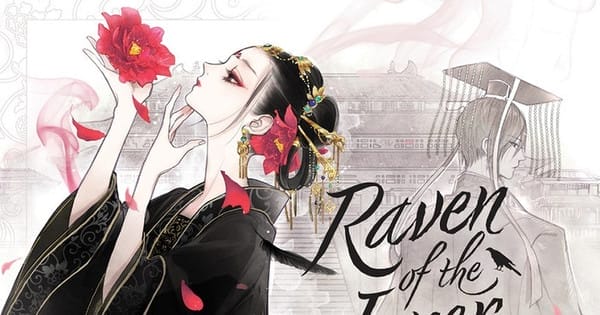
Raven of the Interior Palace Novel 1
The answer to the question of how close the 2022 anime adaptation of Koko Shirakawa’s Raven of the Inner Palace light novels was to the source material is “very.” The most recent heir to the title “Raven Consort,” sixteen-year-old Jusetsu (Shouxue in Crunchyroll’s subs; the novel uses the Japanese reading of the characters’ names while the streams utilized the Chinese reading), is the subject of both versions. The identity of the woman who goes by the moniker is shrouded in mystery, yet most stories concur that she possesses some form of magical ability. The newly ascended emperor Koshun (Gaojun) is worried about a ghost holding a jade earring, which is why he seeks her out. But further he gets to know Jusetsu, the more intrigued he becomes by both her and the role of Raven Consort.
The central plot of this debut novel is driven by Koshun’s attraction to and interest with Jusetsu, as well as her role in the Inner Court’s paranormal investigations. Koshun is clearly in love with Jusetsu despite her snarky ways, and Shirakawa does a great job of weaving the two storylines together. Koshun’s desire to find out more about Raven Consorts is motivated by his love for Jusetsu, as seen from both our perspective and that of other courtiers. The fact that he outright asks her at one point whether she’d be interested in becoming one of his “regular” concubines—a notion she rejects—says a lot about his feelings for her. Jusetsu, on the other hand, is adamant about making the most of her abilities because she feels that the only genuine value she derives from her position is them. We see her helping ghosts (and people afflicted by them) of her own free choice despite her assertions that she demands a fee, and it is obvious that she is dedicated in helping those who deserve it. She will accept it—and perhaps even Koshun—if he can bring her more of those individuals.
Of course, “death” is a central theme in this work. This is partly because Jusetsu has the ability to aid ghosts in their transition to the next world, but it’s also because it plays a significant role in both her life and the emperor’s. We are aware that Koshun ascended to power following the death of his father, but his ancestors did not acquire the throne without spilling blood; his grandfather slaughtered almost all of the previous imperial dynasty. Several significant individuals in Koshun’s life were murdered at her direction, if not by her real hand, by the empress dowager, the father of Koshun. Jusetsu, meantime, was raised by the previous Raven Consort after her mother was murdered in accordance with standing orders concerning the old imperial bloodline that date back to Koshun’s grandfather’s era. When we first meet her, she hasn’t been orphaned for that long. Because Koshun and Jusetsu have both lived close to death, they may be more sensitive to the ghosts who haunt the Inner Palace and more inclined to cooperate with them.
It’s intriguing to wonder why Jusetsu acquired her abilities in the first place. In this volume, we do discover the history of the Raven Consort, and the mythology Shirakawa has created is interesting. There’s a reason why every woman in the Inner Palace holds a bird title, and Jusetsu’s exclusion from the palace has an intriguing connection to the worship of Uren Niangniang, the nation’s founder deity. The empress dowager is the only other woman with any real agency and ability, and it wouldn’t be a leap to call her “evil.” There is a definite sense that the Raven Consort’s repression is connected to efforts to prevent women from holding any power. Is that a result of her being a bad person in general? Or did she become a murderer because she was grabbing at the few scraps of authority she could find? Despite the fact that Jusetsu was taught by her predecessor that it is preferable for her to be alone, the history of Raven Consorts and the concept of female authority do raise this question.
Case-length chapters serve as the book’s divisions, yet it doesn’t have an episodic flavor. Although each mystery is mostly resolved within the (lengthy) chapters, the overall Koshun narrative and the background of the Raven Consort prevent things from becoming choppy. The deaths of the previous imperial family and Jusetsu gradually letting more people into her life against her better judgment are two repeating themes that run through each mystery. However, overall, the novel reads nicely and has a few genuinely moving passages. The translation makes matters worse; while there aren’t many errors, there are still more than I’ve seen in the usual Seven Seas light novel, and there are multiple instances of duplication. As with many light novels, there are parts that are overwritten. Simply expressed, I had the impression that the book needed another edit.
Fans of the film adaptation should enjoy the first book in the Raven of the Inner Palace series. It’s simple to identify the adjustments that were made and comprehend why they took place, and experiencing one version doesn’t exclude experiencing the other. It’s difficult not to appreciate Koshun and Jusetsu since Koshun’s tsundere tendencies are comprehensible and because Koshun genuinely cares about everyone, not to mention the supporting cast members who each have their own unique personalities. This is absolutely worth picking it if you like pseudo-Chinese fantasy.


